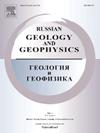Magmatic Native Gold: Composition, Texture, Genesis, and Evolution in the Earth’s Crust
IF 1
4区 地球科学
Q3 GEOSCIENCES, MULTIDISCIPLINARY
引用次数: 0
Abstract
Abstract ––Here we report results of microforms’ studies of native gold and its alloys in igneous rocks, modified to varying degrees by secondary processes. We discuss the composition and occurrence of both the deep-seated magmatic gold-bearing alloys and the products of their transformation under conditions of the upper Earth’s crust. Gold-bearing Kamchatka adakites and ankaramites, Ildeus massif mafic-ultramafic intrusions and adakites from the Stanovoy fold system as well as dacites from the Bolivian Andes were formed during melting of either the suprasubduction mantle wedge or the subducted oceanic crust. In depleted peridotites from the Avachinsky Volcano in Kamchatka as well as suprasubduction ophiolites from Polar Urals, Eastern Sayan and the Western Mediterranean Betic–Rifean belt, the gold-bearing mantle was hybridized by subduction-related melts and high-temperature fluids. Volcanic rocks associated with the Lesser Khingan Fe–Mn deposits and Zolotaya Gora Au deposit in Southern Urals as well as Taragai ultramafic rocks in the South Khingan Range display subduction-related geochemical characteristics. Gold-bearing trachytes in the Virginian Appalachians (USA) represent felsic differentiates of mafic intraplate magmas. We propose that one of the principal forms of gold transport into the upper crustal environments is represented by Cu–Ag–Au alloys, which precipitated from mantle-derived silicate melt enriched in chalcophile and siderophile elements. Such Cu–Ag–Au alloy-rich magmatic rocks can either constitute primary sources of precious metals in the mantle-crust system or serve as geochemical precursors to the formation of native gold assemblages in epithermal and mesothermal ore deposits. Presence of magmatic gold particles in subduction-related igneous rocks and mantle restites hybridized by subduction-derived melts and high-temperature fluids suggest the existence of gold-rich horizons in the Earth’s mantle at depths comparable to typical depths of generation of primary convergent zone and some within-plate magmas.岩浆原生金:地壳的组成、结构、成因和演化
摘要:本文报道了火成岩中原生金及其合金的微形态研究结果,这些微形态经过不同程度的次生作用修饰。讨论了深部岩浆含金合金及其在上地壳条件下的转化产物的组成和赋存状态。含金堪察加埃达克岩和安卡拉岩、伊尔德乌斯地块基性-超镁铁性侵入岩和来自斯坦诺沃伊褶皱体系的埃达克岩以及来自玻利维亚安第斯山脉的英安岩都是在俯冲上地幔楔体或俯冲洋壳的熔融过程中形成的。在堪察加地区阿瓦钦斯基火山的贫化橄榄岩中,以及来自极地乌拉尔、东萨扬和西地中海贝特—里菲亚带的俯冲上蛇绿岩中,含金地幔受到俯冲相关熔体和高温流体的杂化作用。南乌拉尔地区小兴安岭铁锰矿床和佐罗塔亚戈拉金矿床伴生火山岩以及南兴安岭塔拉盖超镁质岩显示出与俯冲有关的地球化学特征。美国弗吉尼亚阿巴拉契亚山脉含金粗面岩代表了镁质板内岩浆的石英分异。我们认为,铜-银-金合金是上地壳环境中金输运的主要形式之一,这种合金由地幔衍生的富含亲铜和亲铁元素的硅酸盐熔体析出。这些富含Cu-Ag-Au合金的岩浆岩既可能是幔壳系统中贵金属的主要来源,也可能是浅成热液和中热液矿床中形成天然金组合的地球化学前兆。岩浆金颗粒存在于俯冲相关的火成岩和地幔残岩中,并与俯冲衍生的熔体和高温流体混合,表明地幔中存在富金层,其深度与原生辐合带的典型生成深度和一些板块内岩浆的形成深度相当。
本文章由计算机程序翻译,如有差异,请以英文原文为准。
求助全文
约1分钟内获得全文
求助全文
来源期刊

Russian Geology and Geophysics
地学-地球科学综合
CiteScore
2.00
自引率
18.20%
发文量
95
审稿时长
4-8 weeks
期刊介绍:
The journal publishes original reports of theoretical and methodological nature in the fields of geology, geophysics, and geochemistry, which contain data on composition and structure of the Earth''s crust and mantle, describes processes of formation and general regularities of commercial mineral occurrences, investigations on development and application of geological-geophysical methods for their revealing. As to works of regional nature, accelerated publication are available for original papers on a variety of problems of comparative geology taking into account specific character of Siberia, adjacent Asian countries and water areas. The journal will also publish reviews, critical articles, chronicle of the most important scientific events, and advertisements.
 求助内容:
求助内容: 应助结果提醒方式:
应助结果提醒方式:


